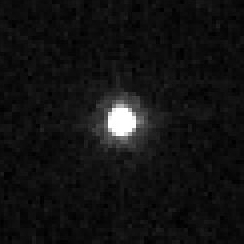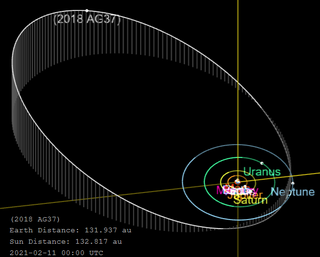Related Research Articles
385571 Otrera, provisional designation 2004 UP10, is a Neptune trojan leading Neptune's orbit in the outer Solar System. It was discovered by American astronomers Scott Sheppard and Chad Trujillo at Las Campanas Observatory on 16 October 2004. It measures approximately 100 kilometers in diameter and was the second such body to be discovered after 2001 QR322.
2005 TN53 is an inclined Neptune trojan leading Neptune's orbit in the outer Solar System, approximately 80 kilometers in diameter. It was first observed on 7 October 2005, by American astronomers Scott Sheppard and Chad Trujillo at Las Campanas Observatory in the Atacama desert of Chile. It was the third such body to be discovered, and the first with a significant orbital inclination, which showed that the population as a whole is very dynamically excited.
385695 Clete, provisional designation 2005 TO74, is a Neptune trojan, co-orbital with the ice giant Neptune, approximately 97 kilometers (60 miles) in diameter. It was named after Clete, one of the Amazons from Greek mythology. The minor planet was discovered on 8 October 2005, by American astronomers Scott Sheppard and Chad Trujillo at Las Campanas Observatory in Chile. 23 known Neptune trojans have already been discovered.

2004 XR190, nicknamed Buffy, is a trans-Neptunian object, classified both as scattered and detached object, located in the outermost region of the Solar System. It was first observed on 11 December 2004, by astronomers with the Canada–France Ecliptic Plane Survey at the Mauna Kea Observatories, Hawaii, United States. The highly inclined dwarf planet candidate measures approximately 560 kilometers (350 miles) in diameter. With its perihelion of 51 AU, it belongs to a small and poorly understood group of very distant objects with moderate eccentricities.
(20161) 1996 TR66 is a trans-Neptunian object orbiting beyond Pluto in the Kuiper belt of the outermost Solar System, approximately 139 kilometers (86 miles) in diameter. It was discovered on 8 October 1996, by astronomers David Jewitt, Chad Trujillo, Jane Luu, and Jun Chen at the Mauna Kea Observatory, Hawaii, in the United States. It was the first discovery of a twotino.

(202421) 2005 UQ513, also written as 2005 UQ513, is a cubewano with an absolute magnitude of 3.4. Mike Brown's website lists it as a highly likely dwarf planet. (202421) 2005 UQ513's spectrum has a weak signature of absorption by water ice. Like Quaoar, it has a very red spectrum, which indicates that its surface probably contains many complex, processed organic molecules. Its light curve shows variations of Δm=0.3 mag, but no period has been determined.

471143 Dziewanna, exact:, provisional designation 2010 EK139, is a trans-Neptunian object in the scattered disc, orbiting the Sun in the outermost region of the Solar System.

1999 XS35 is a near-Earth object discovered in 1999 having a comet-like orbit. Its semi-major axis is 17.8 AU. Its orbital eccentricity is 0.94, which means that at the perihelion 1999 XS35 comes as close as 0.9 AU to the Sun, while at the aphelion it reaches beyond the orbit of Neptune. 1999 XS35 is a damocloid. 1999 XS35 is a small object with an absolute magnitude (H) of 17.2, which implies a size of about 1 km.
2010 KZ39 is a trans-Neptunian object orbiting the Sun as a detached object in the outer reaches of the Solar System. It is likely a dwarf planet as it measures approximately 600 kilometers in diameter. The object was first observed on 21 May 2010 by astronomers Andrzej Udalski, Scott Sheppard, M. Szymanski and Chad Trujillo at the Las Campañas Observatory in Chile.

(523622) 2007 TG422, provisional designation 2007 TG422, is a trans-Neptunian object on a highly eccentric orbit in the scattered disc located in the outermost region of the Solar System, approximately 260 kilometers (160 miles) in diameter. It was discovered on 3 October 2007 by astronomers Andrew Becker, Andrew Puckett and Jeremy Kubica during the Sloan Digital Sky Survey at Apache Point Observatory in New Mexico, United States. According to American astronomer Michael Brown, the bluish object is "possibly" a dwarf planet. It belongs to a group of objects studied in 2014, which lead to the proposition of the hypothetical Planet Nine.
2004 KV18 is an eccentric Neptune trojan trailing Neptune's orbit in the outer Solar System, approximately 70 kilometers in diameter. It was first observed on 24 May 2004, by astronomers at the Mauna Kea Observatories on Hawaii, United States. It was the eighth Neptune trojan identified and the second in Neptune's L5 Lagrangian point.
2010 RF43 is a trans-Neptunian object of the scattered disc orbiting in the outermost regions of the Solar System. It measures approximately 650 kilometers (400 mi) in diameter and is a strong dwarf-planet candidate. The object was first observed on 9 September 2010, by American astronomers David Rabinowitz, Megan Schwamb and Suzanne Tourtellotte at ESO's La Silla Observatory in northern Chile.
1999 TR11, is a resonant trans-Neptunian object from the Kuiper belt, located in the outermost region of the Solar System. The reddish plutino measures approximately 93 kilometers (58 miles) in diameter. It was first observed on 9 October 1999, by American astronomer Scott Sheppard at the Mauna Kea Observatories with the University of Hawaii's 2.2-meter telescope.
2005 VX3 is trans-Neptunian object and retrograde damocloid on a highly eccentric, cometary-like orbit. It was first observed on 1 November 2005, by astronomers with the Mount Lemmon Survey at the Mount Lemmon Observatory in Arizona, United States. The unusual object measures approximately 7 kilometers (4 miles) in diameter. It has the 3rd largest known heliocentric semi-major axis and aphelion. Additionally its perihelion lies within the orbit of Jupiter, which means it also has the largest orbital eccentricity of any known minor planet.
(523671) 2013 FZ27, provisional designation 2013 FZ27, is a trans-Neptunian object and likely dwarf planet, located in the Kuiper belt in the outermost region of the Solar System, approximately 570 kilometers (350 miles) in diameter. It was discovered on 16 March 2013, by American astronomers Scott Sheppard and Chad Trujillo at the CTIO in Chile. Numbered in 2018, this minor planet has not been named.
(523635) 2010 DN93, provisional designation 2010 DN93, is a trans-Neptunian object from in the scattered disc located in the outermost region of the Solar System. It was discovered on 26 February 2010, by astronomers with the Pan-STARRS survey at Haleakala Observatory on the island of Maui, Hawaii, in the United States. The object is "probably" a dwarf planet as it measures approximately 490 kilometers (300 miles) in diameter. It was numbered in 2018 and remains unnamed.

2013 FQ28 is a trans-Neptunian object, both considered a scattered and detached object, located in the outermost region of the Solar System. It was first observed on 17 March 2013, by a team of astronomers at the Cerro Tololo Inter-American Observatory in Chile. It orbits the Sun in a moderate inclined, moderate-eccentricity orbit. The weak dwarf planet candidate measures approximately 260 kilometers (160 miles) in diameter.
2018 VG18 is a distant trans-Neptunian object that was discovered well beyond 100 AU (15 billion km) from the Sun. It was first observed on 10 November 2018 by astronomers Scott Sheppard, David Tholen, and Chad Trujillo during a search for distant trans-Neptunian objects whose orbits might be gravitationally influenced by the hypothetical Planet Nine. They announced their discovery on 17 December 2018 and nicknamed the object "Farout" to emphasize its distance from the Sun.

2018 AG37 (nicknamed FarFarOut) is a distant trans-Neptunian object that was discovered 132.2 ± 1.5 AU (19.78 ± 0.22 billion km) from the Sun, farther than any other currently observable known object in the Solar System. Imaged in January 2018 during a search for the hypothetical Planet Nine, the confirmation of this object was announced in a press release in February 2021 by astronomers Scott Sheppard, David Tholen, and Chad Trujillo. The object was nicknamed "FarFarOut" to emphasize its distance from the Sun. With an estimated diameter of 400 km (250 mi), it is near the lower limit for a dwarf planet candidate.
2014 ST373 (prov. designation:2014 ST373) is a trans-Neptunian object and a detached object from the outermost region of the Solar System. With a perihelion of 50.2 AU, it belongs to the top 10 minor planets with the highest known perihelia of our Solar System. and is neither a scattered disc nor an extreme trans-Neptunian object. It measures approximately 370 kilometers (230 miles) in diameter and was first observed on 25 September 2014, by astronomers using the Dark Energy Camera (DECam) at Cerro Tololo Inter-American Observatory in Chile.
References
- 1 2 3 4 5 "JPL Small-Body Database Browser: 2005 TN74" . Retrieved 30 March 2016.
- ↑ Most SDOs have a perihelion distance greater than 35AU and an eccentricity of more than 0.3.
- ↑ Orbit Fit and Astrometric record for 05TN74
- ↑ Wasserman, L. H.; Buie, M. W.; Marsden, B. G. (5 October 2006). "MPEC 2006-T35 : 2005 PR21, 2005 PT21, 2005 PU21, 2005 TN74". Minor Planet Center . Retrieved 12 May 2008.
- ↑ Sheppard, S. S.; Trujillo, C. A.; Marsden, B. G. (31 October 2005). "MPEC 2005-U97 : 2005 TN74, 2005 TO74". Minor Planet Center. Retrieved 12 May 2008.
- ↑ "Absolute Magnitude (H)". Archived from the original on 2 March 2001. Retrieved 11 May 2008.